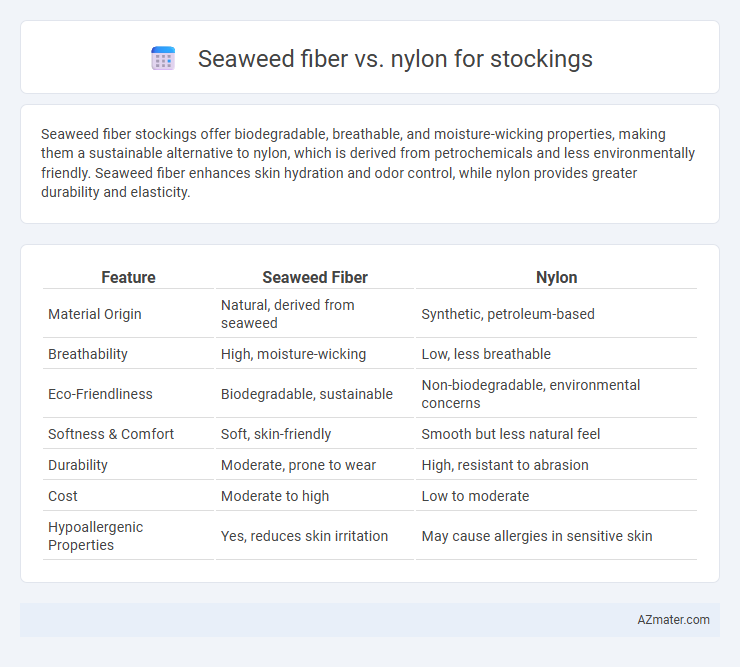Seaweed fiber stockings offer biodegradable, breathable, and moisture-wicking properties, making them a sustainable alternative to nylon, which is derived from petrochemicals and less environmentally friendly. Seaweed fiber enhances skin hydration and odor control, while nylon provides greater durability and elasticity.
Table of Comparison
| Feature | Seaweed Fiber | Nylon |
|---|---|---|
| Material Origin | Natural, derived from seaweed | Synthetic, petroleum-based |
| Breathability | High, moisture-wicking | Low, less breathable |
| Eco-Friendliness | Biodegradable, sustainable | Non-biodegradable, environmental concerns |
| Softness & Comfort | Soft, skin-friendly | Smooth but less natural feel |
| Durability | Moderate, prone to wear | High, resistant to abrasion |
| Cost | Moderate to high | Low to moderate |
| Hypoallergenic Properties | Yes, reduces skin irritation | May cause allergies in sensitive skin |
Introduction: The Evolution of Stocking Materials
Seaweed fiber and nylon represent key milestones in the evolution of stocking materials, with seaweed fiber emerging as a sustainable, eco-friendly alternative to traditional synthetic fibers like nylon. Seaweed fiber offers natural biodegradability and moisture-wicking properties, addressing environmental concerns associated with nylon's petroleum-based production and non-biodegradable nature. Advances in textile technology have enabled seaweed fiber to rival nylon in durability and elasticity, marking a significant shift toward greener fashion innovations.
What is Seaweed Fiber?
Seaweed fiber is an eco-friendly textile derived from natural seaweed biomass, known for its biodegradable and sustainable properties, making it a popular alternative to synthetic fibers like nylon. Unlike nylon, which is petroleum-based and non-biodegradable, seaweed fiber offers excellent moisture absorption, antibacterial benefits, and softness, enhancing comfort in stockings. Seaweed fiber also supports marine ecosystem preservation by utilizing renewable seaweed resources, positioning it as a green solution in the fashion industry.
Understanding Nylon: The Classic Choice
Nylon, a synthetic polymer derived from petrochemicals, remains the classic choice for stockings due to its exceptional strength, elasticity, and resistance to abrasion. Unlike seaweed fiber, nylon offers unparalleled durability and a smooth, sheer finish that enhances comfort and fit. Its moisture-wicking properties and ability to retain shape make nylon stockings ideal for everyday wear and long-lasting use.
Sustainability Comparison: Seaweed Fiber vs Nylon
Seaweed fiber offers a significantly more sustainable alternative to nylon for stockings due to its biodegradability and renewable sourcing from marine algae, which reduces reliance on fossil fuels and lowers carbon emissions. Nylon, derived from petroleum, involves energy-intensive production processes that contribute to pollution and greenhouse gas emissions, while seaweed fiber production supports ocean health and requires minimal chemical use. Choosing seaweed fiber stockings helps minimize environmental impact through reduced waste and promotes circular economy principles compared to synthetic nylon options.
Comfort and Breathability: Which Material Wins?
Seaweed fiber offers superior breathability and moisture-wicking properties compared to nylon, making it exceptionally comfortable for stockings worn in warm or active conditions. Nylon, while durable and elastic, tends to trap heat and moisture, leading to less ventilation and potential discomfort during extended wear. Overall, seaweed fiber outperforms nylon in comfort by promoting better airflow and maintaining a dry, fresh feel on the skin.
Durability and Longevity: Seaweed Fiber or Nylon?
Seaweed fiber stockings offer natural biodegradability and moderate durability, making them an eco-friendly choice but less resilient than nylon. Nylon stockings excel in strength, elasticity, and resistance to wear and tear, providing superior longevity in daily use. For long-lasting performance, nylon remains the preferred material, while seaweed fiber appeals to sustainability-focused consumers seeking a balance between durability and environmental impact.
Skin Health Benefits of Seaweed Fiber Stockings
Seaweed fiber stockings offer superior skin health benefits compared to traditional nylon, thanks to their natural antioxidant and anti-inflammatory properties that help soothe irritation and reduce skin redness. The bioactive compounds in seaweed fiber promote moisture retention and improve skin elasticity, enhancing overall skin hydration and comfort during wear. Unlike nylon, which can trap heat and cause dryness, seaweed fiber stockings provide breathable, hypoallergenic support that minimizes the risk of skin allergies and enhances long-term skin wellness.
Fashion and Aesthetic Appeal: Material Differences
Seaweed fiber stockings offer a natural, eco-friendly texture with a subtle sheen that enhances the aesthetic appeal of sustainable fashion, providing softness and breathability unlike synthetic alternatives. Nylon stockings boast a smooth, glossy finish with high durability and elasticity, creating a sleek, polished look favored in high-fashion ensembles. The distinct material properties influence drape, comfort, and visual impact, making seaweed fiber ideal for organic, understated styles while nylon supports bold, structured designs.
Cost Analysis: Seaweed Fiber vs Nylon Stockings
Seaweed fiber stockings typically cost more upfront due to the sustainable harvesting and specialized processing methods involved, whereas nylon stockings benefit from large-scale synthetic production that lowers unit prices. Over time, seaweed fiber offers potential savings through enhanced biodegradability and reduced environmental impact, potentially lowering disposal costs associated with synthetic materials like nylon. Consumer willingness to pay a premium for eco-friendly products also influences the market pricing dynamics between seaweed fiber and nylon stockings.
Future Trends: The Shift Toward Eco-Friendly Stockings
Seaweed fiber offers a sustainable alternative to traditional nylon in stocking production due to its biodegradability and lower environmental impact. Innovations in seaweed fiber technology enhance durability and elasticity, matching the performance standards of nylon while reducing microplastic pollution. The future of eco-friendly stockings is driven by consumer demand for renewable resources, promoting a significant industry shift from petroleum-based materials to plant-derived fibers like seaweed.

Infographic: Seaweed fiber vs Nylon for Stocking
 azmater.com
azmater.com